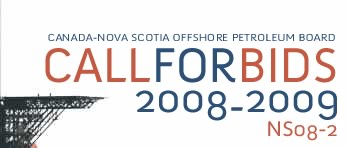
Parcel 1 Exploration Potential
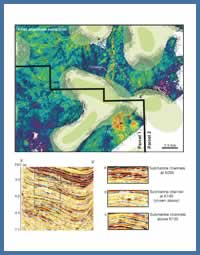
Figure 21
Amplitude extraction from the K140 marker showing an Aptian(?) submarine channel system (on the eastern flank of the Big Thrum prospect - Parcel 2) and corresponding submarine fan deposited above a local step on the middle to lower slope (northern part of the Crows Neck prospect - Parcel 1). A representative seismic profile across the eastern flank of the 'Big Thrum' prospect (line X-X') shows the development of submarine channels at several stratigraphic levels in Lower Cretaceous strata.
Amplitude extraction from the K140 marker showing an Aptian(?) submarine channel system (on the eastern flank of the Big Thrum prospect - Parcel 2) and corresponding submarine fan deposited above a local step on the middle to lower slope (northern part of the Crows Neck prospect - Parcel 1). A representative seismic profile across the eastern flank of the 'Big Thrum' prospect (line X-X') shows the development of submarine channels at several stratigraphic levels in Lower Cretaceous strata.
A large 3D seismic volume (4530 km2) acquired by Shell in the summer of 2000 (Program #NS24-S06-01E) and 2001 (Program #NS24-S06-02E) covers about half of Parcel 1 and was used to identify a number of promising structures (Figure 22). Structural closure appears to exist in both the time and depth domains at several stratigraphic levels within interpreted Missisauga to lower Logan Canyon equivalent deepwater strata (For depth conversion approach, see Shell, 2002; Program NS24-S006-001E/2E). Most traps are either 3-way closures against salt flanks, subsalt, or fault welds, or are associated with folds that require closure of some sort on the flanks of salt, below salt, or along a fault weld (Figure 23). Most structures appear to have been in place by the Late Cretaceous, but were variably modified during a younger period of contraction that was accommodated mostly within isolated salt diapirs (strata were folded above diapirs as they were squeezed, but underlying structures were deformed to a lesser extent). Additional structures with potential closure probably exist in areas with sparser 2D seismic coverage in the western and southern parts of Parcel 1.
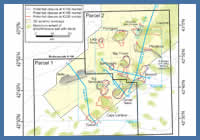
Figure 22a
a) Blob map showing the outlines of potential structural closures identified in 3D seismic at the K230, K195, and K140 seismic markers in Parcels 1 and 2. Where possible, the closure areas were constrained using the C5, C10, and C30 structure maps presented in Shell (2002). 1Note that the velocity model for depth converted structural maps presented in Shell's 'Thrumcap Survey Geophysical Review' (CNSOPB Program NS24-S006-001E/2E), were based on stacking velocities of the sediment layers and water column, but because of anomalous results produced by salt diapirs and salt sheets, a salt layer was not included in the model. A key uncertainty therefore is the effect the isolated salt diapirs and salt sheets/tongues have on the structures described above. Also shown are figure locations, the outline of the Thrumcap 3D seismic volume, and the maximum extent of allochthonous salt and inferred salt stocks.
a) Blob map showing the outlines of potential structural closures identified in 3D seismic at the K230, K195, and K140 seismic markers in Parcels 1 and 2. Where possible, the closure areas were constrained using the C5, C10, and C30 structure maps presented in Shell (2002). 1Note that the velocity model for depth converted structural maps presented in Shell's 'Thrumcap Survey Geophysical Review' (CNSOPB Program NS24-S006-001E/2E), were based on stacking velocities of the sediment layers and water column, but because of anomalous results produced by salt diapirs and salt sheets, a salt layer was not included in the model. A key uncertainty therefore is the effect the isolated salt diapirs and salt sheets/tongues have on the structures described above. Also shown are figure locations, the outline of the Thrumcap 3D seismic volume, and the maximum extent of allochthonous salt and inferred salt stocks.
Seismic stratigraphic studies indicate that there is reservoir potential in Parcel 1 that was not adequately tested by the Newburn H-23 well, located higher up on the slope. Reservoirs are interpreted to consist of Lower Cretaceous turbidite sands deposited as sheets or channeled sheets above areas of reduced gradient in an interpreted middle to lower slope setting (e.g. Figure 21). Sand-rich deltas on the paleo-shelf areas of the western Sable Subbasin are interpreted to have supplied sands via sediment gravity flows through canyons that eroded the outer shelf and upper slope (Figures 11, 12, 18, 19). Sidewall cores from Newburn H-23 in the K230 to K140 interval provide strong evidence for coarse grained channel lags as well as fine-grained turbidites deposited in overbank settings (i.e. on the levees of submarine channels). This may indicate that the well is positioned in an upper to middle slope setting dominated by bypassing Early Cretaceous sediment gravity flows. The removal of fines from turbidity currents through overbank deposition also provides a mechanism for enriching the sand-content of flows that continue to travel down slope (i.e. as mud is preferentially removed and deposited on levees, a flow becomes more sand-rich so long as equivalent quantities of mud are not also eroded from the substrate and re-incorporated into the flow).
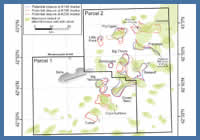
Figure 22b
Same blob map presented in (a) but without bathymetric contours, 3D seismic coverage, and figure locations.
Same blob map presented in (a) but without bathymetric contours, 3D seismic coverage, and figure locations.
Seismic facies interpretations in the Newburn area are tenuous, but seismic imaging improves significantly in the areas of Parcels 1 and 2 where there is evidence for lens-shaped deposits interpreted as sand-prone submarine lobes (e.g. Figure 23) locally eroded by submarine channels (e.g. Figure 21). Some reservoir potential may also exist in the J280 to J265 interval, which is interpreted to contain submarine fans supplied from Mic Mac Formation clastic sources on the shelf NW of Parcel 1 during periods of low sea level and exposure of the carbonate bank.
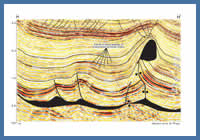
Figure 23
Profile H to H' showing the key structure types in the areas of Parcels 1 and 2. Most traps are either 3-way closures against salt flanks, subsalt, or fault welds, or are associated with folds that require closure of some sort on the flanks of salt, below salt, or along a fault weld. Note the seismic facies character between the K230 and K140 markers, consisting of interfingering of seismic loops with subtle baselap-onlap relationships interpreted as compensationally stacked sand-prone turbidite lobes. See Figure 22a for location.
Profile H to H' showing the key structure types in the areas of Parcels 1 and 2. Most traps are either 3-way closures against salt flanks, subsalt, or fault welds, or are associated with folds that require closure of some sort on the flanks of salt, below salt, or along a fault weld. Note the seismic facies character between the K230 and K140 markers, consisting of interfingering of seismic loops with subtle baselap-onlap relationships interpreted as compensationally stacked sand-prone turbidite lobes. See Figure 22a for location.
Seals are provided by marine shales that separate turbidite sands, combined with a thick interval of shale-dominated Logan Canyon equivalent strata that drapes most structures. Based on the gas bearing sands encountered in Newburn H-23 (and several other deepwater wells on the Scotian slope - Kidston et al., 2007), the hydrocarbon type is inferred to be gas generated from Verrill Canyon shales (Mukhopadhyay, 2006). There may also be potential for oil generating source rocks in Mohican equivalent deeper water strata (e.g. the J350 to J280 interval corresponding to the first minibasins to load autochthonous salt – Figure 10), or even older Eurydice equivalent synrift lacustrine deposits (e.g. autochthonous salt is commonly underlain by a mixed amplitude interval interpreted to correspond to synrift clastics or bedded salt deposited in grabens and half-grabens – Figure 15). Please refer to Mukhopadhyay (2006) and the references therein for further details about potential source rocks.
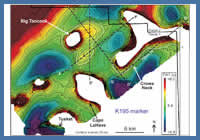
Figure 24
Time-structure map of the K195 marker in Parcel 1, showing the Big Tancook and Crows Neck structures. See text for discussion.
Time-structure map of the K195 marker in Parcel 1, showing the Big Tancook and Crows Neck structures. See text for discussion.
Structures on Parcel 1
The Big Tancook structure (Figure 22), located in water depths of about 2550 m, is a symmetrical fold with 4-way dip-closure in both the time and depth domains at several Missisauga to Logan Canyon deepwater equivalent stratigraphic levels (for depth conversion approach, see Shell, 2002; Program NS24-S006-001E/2E). The crest of the structure is located between 6800 m TVD-ss (at the K230/C5 marker) and 5500 m TVD-ss (at the K140/C30 marker) (Shell, 2002). Big Tancook consists of two main compartments, one to the north and one to the south, separated by a subtle saddle (Figure 24). The northern side of each compartment is bordered by a landward-vergent reverse fault with offset of seismic reflections below the J265 marker, and little or no offset of markers above K230 (Figure 25). Several additional cv4restal faults are present above the southern compartment, however because of their relatively minor throws and the interpreted presence of thick Logan Canyon equivalent shales above the structure, they are not expected to compromise trap integrity (see profile F – F’ in Figure 25). A detached/ teardrop salt diapir overlies the structure, and its stock passed through the western side of the northern compartment. Seismic imaging below the teardrop diapir is poor in time-migrated data, so it is uncertain to what extent the stock has been welded closed. Sealed contacts with impermeable salt or a salt weld are probably required to maintain trap integrity. Maximum closed contours encompass both the northern and southern compartments (Figure 24), with a closure area of up to 43 km2. Using a minimum area of 12 km2 and a maximum potential area of 40 km2 (with a most likely (P50) of 26 km2), and assuming a net pay thickness that ranges from one 20 m turbidite sand to four 30 m turbidite sands (net pay of 120 m), with average porosities ranging from 12 to 20%, we estimate that Big Tancook has 1.33 Tcf (P90) to 4.13 Tcf (P10) of in-place gas, with a mean of 2.62 Tcf (calculated using @Risk probability analysis software).
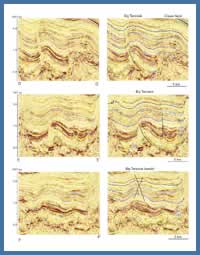
Figure 25
Three uninterpreted (left) and interpreted (right) seismic profiles across the Big Tancook structure in Parcel 1 (profile D-D', E-E', and F-F'). See Figure 24 for location.
Three uninterpreted (left) and interpreted (right) seismic profiles across the Big Tancook structure in Parcel 1 (profile D-D', E-E', and F-F'). See Figure 24 for location.
The Crows Neck structure, located southeast of Big Tancook (Figures 22, 24), is a three-way closure onto salt that could cover an area greater than 25 km2 at multiple stratigraphic levels. Recognition of south-oriented submarine channels passing over the Big Thrum structure (Parcel 2 – directly north of the Crows Neck structure) at several stratigraphic levels, suggest that Crows Neck was located along an active turbidite corridor during the Early Cretaceous (Figure 21). An amplitude extraction from the K140 marker, for example, shows a narrow south-oriented submarine channel believed to have supplied sands to a broader submarine fan on the northern part of the Crows Neck structure (Figure 26). Amplitude maps from deeper stratigraphic levels (K230 and K195) also show some conformance of the highest amplitudes to the structural contours.
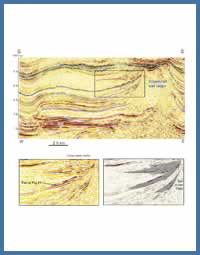
Figure 26
Seismic profile G to G’ showing the Crows Neck structure, with high amplitude reflections onlapping a squeezed salt structure to the right. One of these high amplitude reflections corresponds to the fan shown in Figure 21. See Figure 22 and 24 for location.
Seismic profile G to G’ showing the Crows Neck structure, with high amplitude reflections onlapping a squeezed salt structure to the right. One of these high amplitude reflections corresponds to the fan shown in Figure 21. See Figure 22 and 24 for location.
There are several additional salt flank to subsalt plays within the 3D seismic area, including the Tusket and Cape LaHave structures, which are three-way closures against squeezed salt diapirs, variably affected by folding that took place in response to upslope extension. Tusket is located at the southern edge of the 3D survey, and presumably extends beyond the data-set. It is characterized by anomalously high amplitude reflections within the K230 to K195 interval that terminate against a counter-regional normal fault (Figure 27). High amplitude reflections are also observed on some parts of Cape LaHave. A prominent scour between the Tusket and Cape LaHave diapirs just below the K140 maker implies this area was also located along an active turbidite corridor.
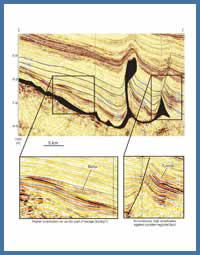
Figure 27
Seismic profile I to I' showing the Tusket structure, characterized by anomalously high amplitude reflections terminating against a counter-regional normal fault. Also shown is "Bella", a potential stratigraphic trap in the northern part of Parcel 1. See text for details and Figure 22a for location.
Seismic profile I to I' showing the Tusket structure, characterized by anomalously high amplitude reflections terminating against a counter-regional normal fault. Also shown is "Bella", a potential stratigraphic trap in the northern part of Parcel 1. See text for details and Figure 22a for location.
Finally, if the shingled/interfingering high to moderate amplitude seismic response between the J280 and J265 markers is produced by alternating clastic submarine fans and slope carbonates, there may be significant potential for stratigraphic traps in the northern part of Parcel 1, where the interval pinches out onto the steep carbonate foreslope (identified as ‘Bella” in Figure 27). Bella extends for more than 22 km along strike, with its highest amplitude parts covering more than 60 km2 near its upslope termination. These deposits could be analogous to the Buzzard field in the North Sea, which contains 400 million barrels of oil in Late Jurassic reservoirs that form a wedge-shaped stratigraphic trap that thins onto the slope (Forster, 2005).
Figure Captions
Figure 21. Amplitude extraction from the K140 marker showing an Aptian(?) submarine channel system (on the eastern flank of the Big Thrum prospect – Parcel 2) and corresponding submarine fan deposited above a local step on the middle to lower slope (northern part of the Crows Neck prospect – Parcel 1). A representative seismic profile across the eastern flank of the ‘Big Thrum’ prospect (line X-X’) shows the development of submarine channels at several stratigraphic levels in Lower Cretaceous strata.
Figure 22. a) Blob map showing the outlines of potential structural closures identified in 3D seismic at the K230, K195, and K140 seismic markers in Parcels 1 and 2. Where possible, the closure areas were constrained using the C5, C10, and C30 structure maps presented in Shell (2002). 1Note that the velocity model for depth converted structural maps presented in Shell’s ‘Thrumcap Survey Geophysical Review’ (CNSOPB Program NS24-S006-001E/2E), were based on stacking velocities of the sediment layers and water column, but because of anomalous results produced by salt diapirs and salt sheets, a salt layer was not included in the model. A key uncertainty therefore is the effect the isolated salt diapirs and salt sheets/tongues have on the structures described above. Also shown are figure locations, the outline of the Thrumcap 3D seismic volume, and the maximum extent of allochthonous salt and inferred salt stocks. b) Same blob map presented in (a) but without bathymetric contours, 3D seismic coverage, and figure locations.
Figure 23. Profile H to H’ showing the key structure types in the areas of Parcels 1 and 2. Most traps are either 3-way closures against salt flanks, subsalt, or fault welds, or are associated with folds that require closure of some sort on the flanks of salt, below salt, or along a fault weld. Note the seismic facies character between the K230 and K140 markers, consisting of interfingering of seismic loops with subtle baselap-onlap relationships interpreted as compensationally stacked sand-prone turbidite lobes. See Figure 22a for location.
Figure 24. Time-structure map of the K195 marker in Parcel 1, showing the Big Tancook and Crows Neck structures. See text for discussion.
Figure 25. Three uninterpreted (left) and interpreted (right) seismic profiles across the Big Tancook structure in Parcel 1 (profile D-D’, E-E’, and F-F’). See Figure 24 for location.
Figure 26. Seismic profile G to G’ showing the Crows Neck structure, with high amplitude reflections onlapping a squeezed salt structure to the right. One of these high amplitude reflections corresponds to the fan shown in Figure 21. See Figure 22 and 24 for location.
Figure 27. Seismic profile I to I’ showing the Tusket structure, characterized by anomalously high amplitude reflections terminating against a counter-regional normal fault. Also shown is “Bella”, a potential stratigraphic trap in the northern part of Parcel 1. See text for details and Figure 22a for location.


